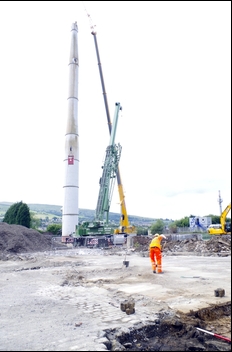Surrey Street, Glossop, Derbyshire. Archaeological Excavation. (OASIS ID: wessexar1-262922)
Wessex Archaeology, 2018. https://doi.org/10.5284/1046766. How to cite using this DOI
Data copyright © Wessex Archaeology unless otherwise stated
This work is licensed under the ADS Terms of Use and Access.
Primary contact
Jessica
Irwin
Finds and Archives Supervisor
Wessex Archaeology
Unit R6
Riverside Block
Sheaf Bank Business Park
S2 3EN
UK
Resource identifiers
- ADS Collection: 3049
- DOI:https://doi.org/10.5284/1046766
- How to cite using this DOI
Introduction

Wessex Archaeology was commissioned by Ecus Ltd, acting on behalf of Westleigh Partnership Ltd, to undertake a combined programme of archaeological watching brief, evaluation trenching and mitigation at the location of the former Ferro Alloys company, Surrey Street, Glossop, Derbyshire. The site is centred on National Grid Reference SK 402990, 394028.
The archaeological works were being conducted in advance of a residential development and fulfil planning condition 10 of planning application HPK/2015/0113.
The programme of archaeological works identified well preserved structures and a largely intact floor of the Victorian foundry. The excavation identified that elements of the original 1860s structure survived, with the stone bases of cast iron stanchions and the western and northern front wall intact. Internal pits, being probable casting pits, a large machine base within the engine house and the foundations of a brick chimney, with a related brick flue and engine house flooring were found in the excavations. Many of these structures are likely relate to the early phase of works in the foundry. An extension to the eastern side of the foundry was built between 1894 and 1898 with further extensions to the rear at this time. Evidence for these extensions was identified during the archaeological works. Evidence for later alterations to the internal layout of the Victorian foundry was also identified in the form of inserted internal walls, stanchions and pits.
The focus of the Iron works changing to incorporate Ferro-alloy workings meant further adaptions in the mid-1930s and the same company continued working here, adapting and expanding again in the 1960s and 70s. The newest large chimney, that had long been a contentious landmark for Glossop, was built in 1977 and expanded to 400ft high in the 1980s to stop the pollution from the chimney dropping on the residents of Glossop.
The environmental assemblage was largely composed of a mixture of crushed drossy slag, cinders and possibly waste casting sand. The residues are of the type one might expect to find on a foundry site operating coke fired cupola furnaces. lt should be borne in mind that changes to the chemistry of the samples may have taken place in their post-depositional environment. The historic records relating to the site mention the former presence of cupola furnaces, as well as more recent processes, which included the production of molybdenum from molybdenum sulphide. A sample taken from the inner lining of weighbridge is molybdenum sulphide that has collected in the subterranean cavity.
The project archive resulting from the excavation will be deposited with the Archaeology Data Service.





